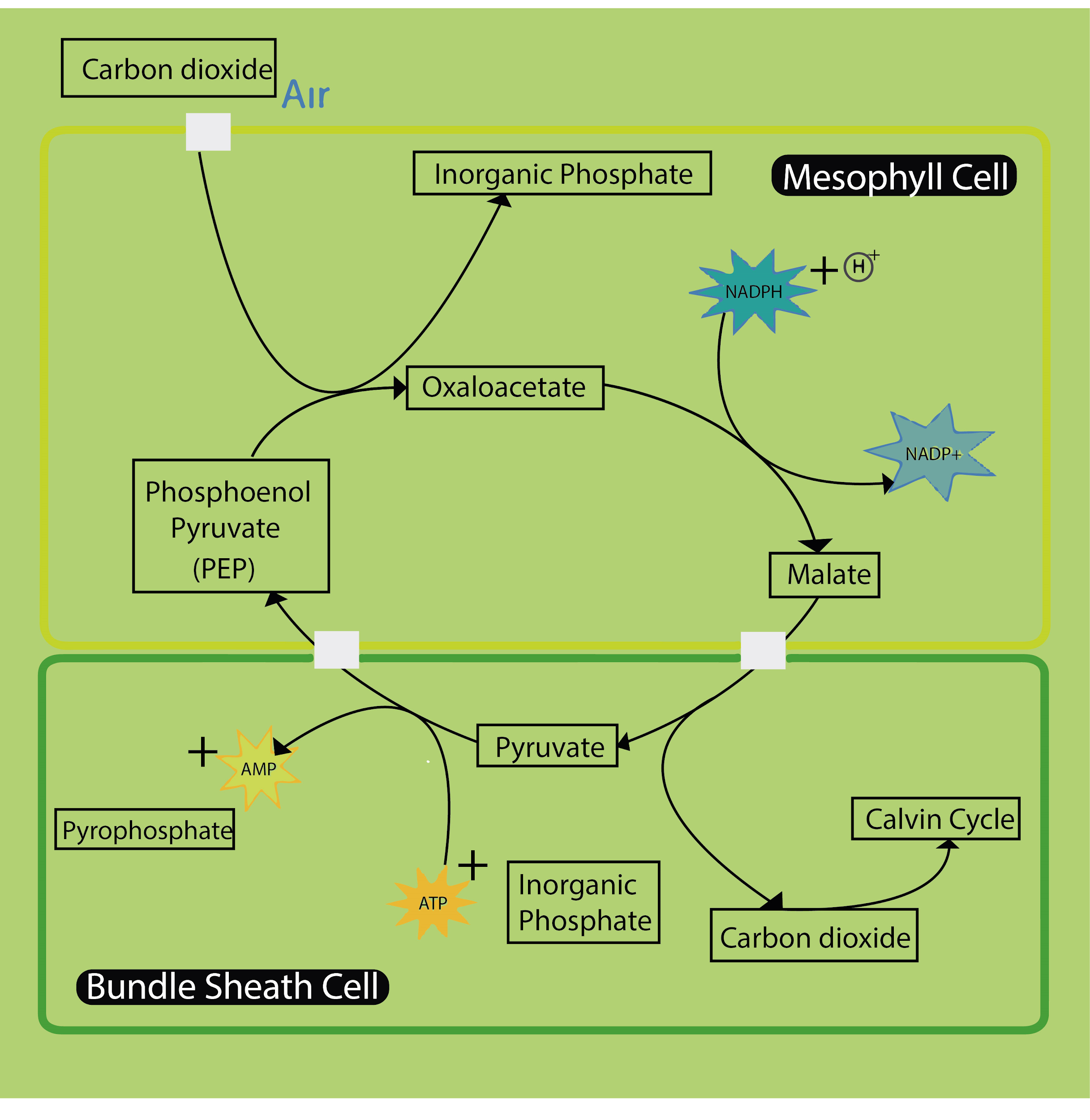
${C}_{4}$ -cycle discovered by
(a)Hatch and Slack
(b)Calvin
(c)Hill
(d)Arnon
Answer
468.9k+ views
Hint: Australian botanists in 1966 researched that there are two kinds of chloroplasts in sugarcane. The discovery of ${C}_{4}$ cycle in monocots like sugarcane, maize, and sorghum has specified that these plants have resolved the matter of photorespiration.
Complete answer:
${C}_{4}$ cycle which is also referred to as the Hatch-Slack pathway is a cyclic process. It occurs in chloroplasts. ${C}_{4}$ -cycle was discovered by two Australian scientists Hatch and Slack. It is found in ${C}_{4}$ plants. Carbon dioxide fixation is done in this pathway. The primary ${CO}_{2}$ acceptor is the three-carbon molecule phosphoenolpyruvate (PEP) and it is present in mesophyll cells. The enzyme which catalyzes the ${CO}_{2}$ fixation is PEP carboxylase or PEPcase. The mesophyll cells of ${C}_{4}$ plants do not contain the enzyme RuBisCO. The 4-carbon oxaloacetic acid (OAA) is made within the mesophyll cells which is further converted into the malic acid or amino acid then transported into bundle sheath cells. In the bundle sheath cells, these ${C}_{4}$ acids are weakened to release ${CO}_{2}$ and a three-carbon molecule.
Additional information:
${C}_{4}$ photosynthesis comprise novel leaf anatomy, metabolic specializations, and altered gene expression. Plants that use this pathway basically have a specific Kranz leaf anatomy, consisting of two photosynthetic cell types. Their vascular bundles are surrounded by two rings of cells. The innermost ring also referred to as bundle sheath cells contain starch-rich chloroplasts lacking grana, which vary from those in mesophyll cells located as the outer ring. This structural framework allows for the categorization and functional division of two pairs of carboxylation and decarboxylation reactions.

So, the correct answer is ‘Hatch and Slack’.
Note: The light-dependent reactions and the Calvin cycle are divided in the ${C}_{4}$ plants. The Calvin cycle takes place in the bundle-sheath cells and the light-dependent reactions occur in the mesophyll cells. In ${C}_{4}$ grasses such as maize, the mesophyll cells surround the bundle sheath cells, and the bundle sheath cells enclose the veins. ${C}_{4}$ photosynthesis is present in many plant species, mainly in monocots (like maize, sugar cane, and grasses) but also in many dicots (like amaranth and flaveria).
Complete answer:
${C}_{4}$ cycle which is also referred to as the Hatch-Slack pathway is a cyclic process. It occurs in chloroplasts. ${C}_{4}$ -cycle was discovered by two Australian scientists Hatch and Slack. It is found in ${C}_{4}$ plants. Carbon dioxide fixation is done in this pathway. The primary ${CO}_{2}$ acceptor is the three-carbon molecule phosphoenolpyruvate (PEP) and it is present in mesophyll cells. The enzyme which catalyzes the ${CO}_{2}$ fixation is PEP carboxylase or PEPcase. The mesophyll cells of ${C}_{4}$ plants do not contain the enzyme RuBisCO. The 4-carbon oxaloacetic acid (OAA) is made within the mesophyll cells which is further converted into the malic acid or amino acid then transported into bundle sheath cells. In the bundle sheath cells, these ${C}_{4}$ acids are weakened to release ${CO}_{2}$ and a three-carbon molecule.
Additional information:
${C}_{4}$ photosynthesis comprise novel leaf anatomy, metabolic specializations, and altered gene expression. Plants that use this pathway basically have a specific Kranz leaf anatomy, consisting of two photosynthetic cell types. Their vascular bundles are surrounded by two rings of cells. The innermost ring also referred to as bundle sheath cells contain starch-rich chloroplasts lacking grana, which vary from those in mesophyll cells located as the outer ring. This structural framework allows for the categorization and functional division of two pairs of carboxylation and decarboxylation reactions.

So, the correct answer is ‘Hatch and Slack’.
Note: The light-dependent reactions and the Calvin cycle are divided in the ${C}_{4}$ plants. The Calvin cycle takes place in the bundle-sheath cells and the light-dependent reactions occur in the mesophyll cells. In ${C}_{4}$ grasses such as maize, the mesophyll cells surround the bundle sheath cells, and the bundle sheath cells enclose the veins. ${C}_{4}$ photosynthesis is present in many plant species, mainly in monocots (like maize, sugar cane, and grasses) but also in many dicots (like amaranth and flaveria).
Recently Updated Pages
The correct geometry and hybridization for XeF4 are class 11 chemistry CBSE

Water softening by Clarks process uses ACalcium bicarbonate class 11 chemistry CBSE

With reference to graphite and diamond which of the class 11 chemistry CBSE

A certain household has consumed 250 units of energy class 11 physics CBSE

The lightest metal known is A beryllium B lithium C class 11 chemistry CBSE

What is the formula mass of the iodine molecule class 11 chemistry CBSE

Trending doubts
Is Cellular respiration an Oxidation or Reduction class 11 chemistry CBSE

In electron dot structure the valence shell electrons class 11 chemistry CBSE

What is the Pitti Island famous for ABird Sanctuary class 11 social science CBSE

State the laws of reflection of light

One Metric ton is equal to kg A 10000 B 1000 C 100 class 11 physics CBSE

Difference Between Prokaryotic Cells and Eukaryotic Cells




